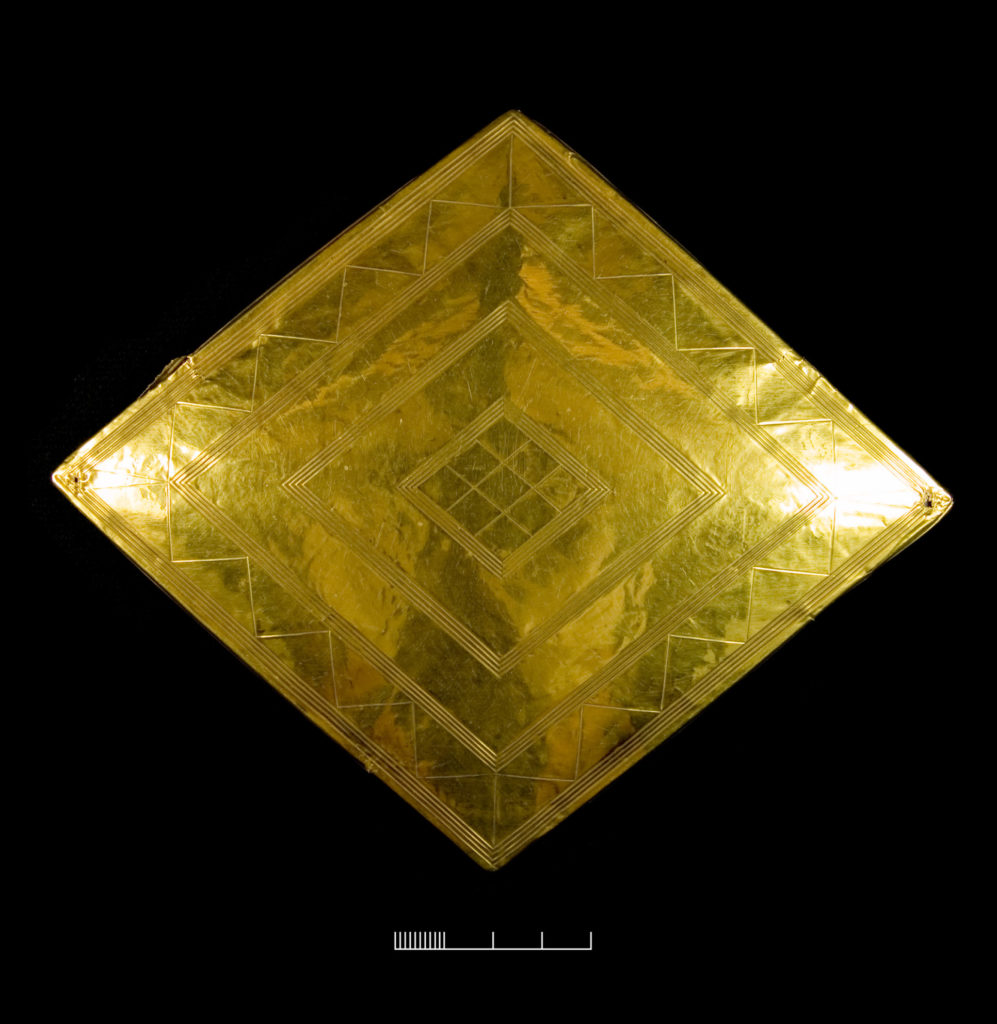What the heck is a lek?
Males great bustards perform spectacular courtship displays, gathering at a ‘lek’ or small display ground to try to impress the females.
The lozenge is the finest example of Bronze Age gold craftsmanship ever found. Made from sheet gold, only one millimetre thick, it is incised with intricate patterns, suggesting that whoever made it had a sophisticated knowledge of geometry.

Home » Collections showcase » Bush Barrow lozenge
The lozenge was buried on the chest of its owner, known as the Bush Barrow chieftain, in a round barrow close to Stonehenge. He must have been important – perhaps a priest, warrior or chief – and the lozenge was probably used to fasten his cloak.
The lozenge measures 184mm long by 156 mm wide.
The Bush Barrow chieftain was found at a burial site known as Bowl Barrow Wilsford G5, excavated by William Cunnington in 1808. As well as the lozenge, the burial included a ceremonial mace, a flat bronze axe and two bronze daggers.
When Wessex Museums commissioned Ann-Marie James to create a contemporary art exhibition, she chose one object from each museum as her inspiration.
At Wiltshire Museum she chose the Bush Barrow lozenge, and named the series of artworks ‘Chieftain’. She said:
“What interested me about the lozenge was the precision of its incised lines – this detailed geometry seemed mysterious given that it was made in the Bronze Age. The abstract nature of my paintings reflect this ambiguity, bringing an artefact from the past, in altered form, into the present.”


“…The first attempts made by Mr. Cunnington on this barrow proved unsuccessful, as also those of some farmers, who tried their skill in digging into it. Our researches were renewed in September, 1808, and we were amply repaid for our perseverance and former disappointment. On reaching the floor of the barrow, we discovered the skeleton of a stout and tall man lying from south to north: the extreme length of his thigh bone was 20 inches…
Immediately over the breast of the skeleton was a large plate of gold, TUMULI PLATE XXVI, in the form of a lozenge, and measuring 7 inches by 6. It was fixed to a thin piece of wood, over the edges of which the gold was lapped: it is perforated at top and bottom, for the purpose, probably, of fastening it to the dress as a breast-plate. The even surface of this noble ornament is relieved by indented lines, checques, and zigzags, following the shape of the outline, and forming lozenge within lozenge, diminishing gradually towards the centre.”
| Cookie | Duration | Description |
|---|---|---|
| cookielawinfo-checkbox-analytics | 11 months | This cookie is set by GDPR Cookie Consent plugin. The cookie is used to store the user consent for the cookies in the category "Analytics". |
| cookielawinfo-checkbox-functional | 11 months | The cookie is set by GDPR cookie consent to record the user consent for the cookies in the category "Functional". |
| cookielawinfo-checkbox-necessary | 11 months | This cookie is set by GDPR Cookie Consent plugin. The cookies is used to store the user consent for the cookies in the category "Necessary". |
| cookielawinfo-checkbox-others | 11 months | This cookie is set by GDPR Cookie Consent plugin. The cookie is used to store the user consent for the cookies in the category "Other. |
| cookielawinfo-checkbox-performance | 11 months | This cookie is set by GDPR Cookie Consent plugin. The cookie is used to store the user consent for the cookies in the category "Performance". |
| viewed_cookie_policy | 11 months | The cookie is set by the GDPR Cookie Consent plugin and is used to store whether or not user has consented to the use of cookies. It does not store any personal data. |

Males great bustards perform spectacular courtship displays, gathering at a ‘lek’ or small display ground to try to impress the females.
The great bustard has a dignified slow walk but tends to run when disturbed, rather than fly.
The hen-bird on display at The Salisbury Museum was one of the last great bustards to be eaten in the town!